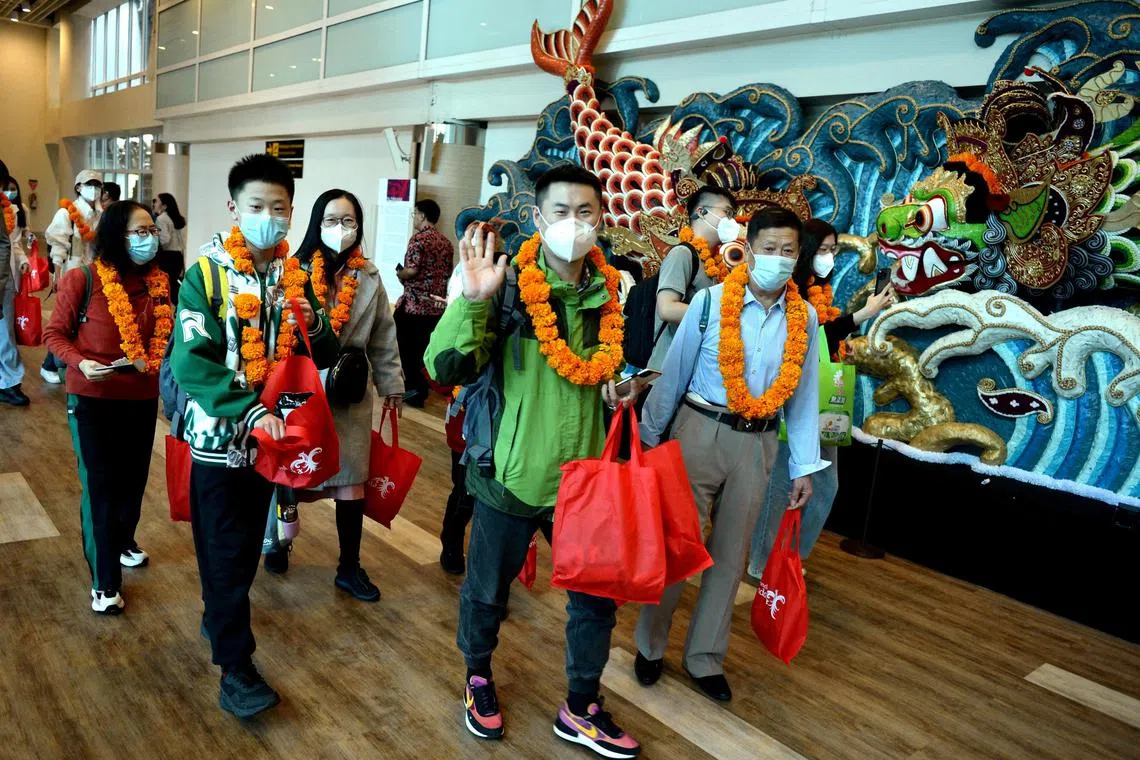Bali aims for big spenders as Chinese tourists slowly return
Sign up now: Get ST's newsletters delivered to your inbox

The first batch of Chinese tourists after China lifted Covid-19 travel restrictions arriving at Ngurah Rai International Airport in Bali, on Jan 22, 2023.
PHOTO: REUTERS
Follow topic:
BALI – Business may be at only a fraction of the levels reached three years ago, but Mr Putu Darmaya, founder of tour and resort operator Caspla Bali, is confident that a tourism recovery is finally at hand.
In January, China lifted Covid-19 travel restrictions,
For Mr Putu, 46, who had mostly relied on Chinese tourists for his business that offers day trips and stays on Nusa Penida, an island south-east of Bali, Beijing’s decision was nothing less than a stay of execution.
“If the Covid-19 restrictions had gone on much longer, we would have gone bankrupt,” Mr Putu told The Straits Times.
In better days before the pandemic, he employed 200 people. Also, in 2019, he had taken out a 50 billion rupiah (S$4.4 million) bank loan to add boats and expand his 26-room resort on Nusa Penida. He is now preparing to ramp up business again.
“Even though it is a small number of travellers, I’ve started calling my workers to come back to work.”
In 2019, arrivals from China numbered nearly 1.2 million, just slightly behind the Australians, who formed the largest group with 1.23 million arrivals. The return of Chinese holidaymakers will be a welcome lift for the recovery of Bali’s all-important travel industry.
Tourism officials say the recovery will be slow as airlines struggle for aircraft and Bali aims for higher-spending travellers.
“We predict the number of flights will begin to improve by the middle of 2023,” Mr Ida Bagus Agung Partha Adnyana, chairman of the Bali Tourism Board, told ST.
Australians reclaimed the top spot for Bali arrivals in 2019 owing to a crackdown on shady package tours aimed at corralling Chinese travellers into businesses owned by their countrymen.
Known as “zero-dollar tours”, the schemes lured tourists with free – or almost free – flights, food and accommodation, only to pressure them once they were in Bali into buying goods made in China, such as silk apparel and kitchen appliances. The purchases would be delivered to their homes back in China. These schemes were estimated to have diverted US$1,500 (S$1,995) in revenue per traveller away from local businesses.
In 2018, Bali’s government shut down 16 businesses owned by Chinese nationals that were offering hefty kickbacks in return for funnelling tourists to their stores.
“We don’t want that to happen again,” Mr Ida Bagus said. “We are focused on quality, not quantity.”
Since the onset of the pandemic, the local government has trained up some 600 local Balinese tour guides, including loading up the graduates with basic Chinese language skills through free courses. The aim is to supplant non-native guides who do not know the island as well as locals do, Mr Ida Bagus said.
In late January, Indonesian low-cost carrier Lion Air began once-weekly direct flights between Bali and Shenzhen.
Taiwan-based carriers China Airlines and Eva Air together operate five flights a week between China and Bali via Taipei.
Longer term, though, the industry will need to contend with an aircraft shortage that crimps the ability of airlines to add capacity, experts said.
More than 160 direct flights operated between China and Bali in December 2019, according to local airport data.
Last month, France’s Airbus, the world’s biggest aircraft-maker said its deliveries in 2022 added up to 661 planes – falling short of its original goal of 720 for the year, owing to supply chain snags.
Even so, for business operators like Mr Putu, a native of Nusa Penida, the slow uptick in arrivals from China is better than nothing.
On a recent weekday, he had 70 passengers on his boat for a day trip from Bali’s main island to Nusa Penida, where they will splash out on dining, snorkelling and riding jet skis. While that total represents only 5 per cent of the number of day trippers Mr Putu had daily during particularly busy times, he remains optimistic.
“The Chinese market is huge,” he said. “We like to have them come to Bali.”


